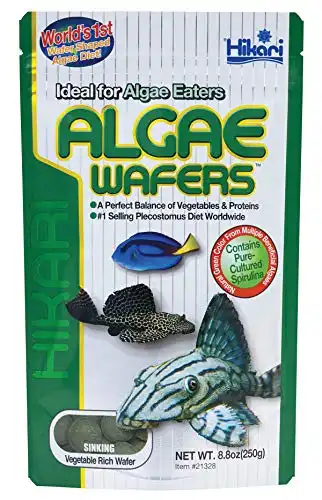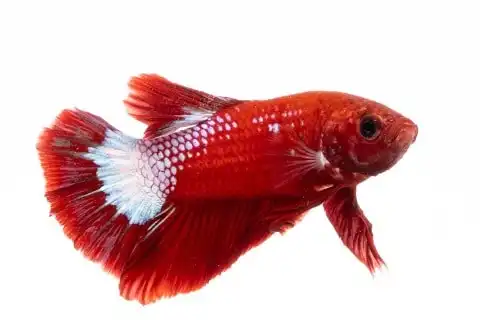Thank you for visiting! By the way… any links on this page that lead to products on Amazon and other stores/partners are affiliate links Aquarium Store Depot earns a commission if you make a purchase.
Don’t lose hope if you find your aquarium fish with bulging eyes, struggling to see. This is a treatable condition known as Fish Popeye Disease that can be taken care of through proper knowledge and attention! In this blog post, we’ll provide all the necessary information on how to identify its causes and symptoms in order to prevent it from occurring again – equipping you with everything needed for your aquatic friends’ well-being.
Key Takeaways
- Popeye Disease is a condition that causes fluid buildup in fish eyes, leading to infection and blindness if untreated.
- Preventing it requires maintaining water conditions, providing a vitamin-rich diet, using appropriate decor, and reducing stress factors.
- Treatment involves Epsom salt for swelling relief as well as antibiotics like Kanaplex, depending on the species affected.
What Is Fish Pop Eye Disease
Fish are particularly susceptible to Popeye Disease due to weakened immune systems and poor water conditions. This condition causes a fluid buildup behind or within the eyes, leading to severe infections which can result in potential blindness. Depending on its cause, this fish disease may either be infectious (if caused by a bacterial infection) or not if physically injured.
Infected fish have been known to spread quickly among other species of fish if left untreated. It could even lead to organ failure besides just potentially blinding them completely. Recognizing signs early and taking adequate steps for prevention as well as treatment is essential for ensuring healthy underwater environments with your pet fish.
Identifying The Condition

The Popeye Disease is marked by one or both of the fish’s eyes protruding outwards from its socket, and early symptoms can be subtle such as slight bulging and changes in behavior. It may manifest unilaterally (in a single eye) or bilaterally (both eyes), often caused due to poor water quality or an infection that has gone untreated1.
If not taken care of, the condition can lead to other issues within your fish that may be fatal. Your fish could also lose their eyes.
Recognizing Symptoms
Monitoring the condition of your fish and their habitat closely can help detect symptoms of Popeye Disease while it’s still in its early phases, increasing chances of successful recovery. Fish may be more likely to sustain an injury that leads to this disease if they’re either high-energy or overly timid because then they are more apt at bumping into tank decorations with potentially sharp edges.
Having a lesser immunity than other animals makes them particularly susceptible to bacteria which cause infectious diseases like Popeye Disease. When left unchecked, swelling around the eye area can become prominent as the illness progresses further.
Prevention Methods
In order to protect the fish in your aquarium from Popeye Disease, it is important to maintain good water conditions, provide a vitamin-rich diet and create an environment with suitable decor. Reducing stress factors for aquatic creatures will play a role in preventing this condition.
We’ll take a closer look at each of these measures so you can keep your finned friends healthy and free of any popeye issues! Here’s a quick outline of the 4 ways to prevent:
- Proper water conditions
- A well balanced diet
- Proper decor choices
- Reducing stress
1. Ensuring Optimal Water Conditions
In order to stop Popeye Disease from occurring in aquariums, it is essential that the correct water conditions be maintained. Depending on what type of aquarium fish species are kept, factors such as pH balance and temperature can play a huge role. Checking these levels frequently and doing partial tank changes weekly will ensure healthy water for your aquatic friends. Making sure there’s no detectable ammonia or nitrates in the environment helps prevent this fish disease from happening at all! Here are some basic parameters to follow:
pH and temperature are dependent on your fish species. Check out our overview of all tropical fish types for some basic and our individual care articles for detailed parameters for every fish in the hobby!
2. Feeding A Vitamin Rich Diet
Fish need a balanced and nutritious diet to help prevent any common fish disease they could be afflicted with. Depending on your fish, their diet will differ, but we can provide a few guidelines here.
Carnivornes and Omnivornes
- Flake – High quality flake food with probiotics
- Pellets – Flakes with high protein or insect matter for digestibility to prevent bloat
- Frozen/Freeze Dried – Daphnia, Brine shrimp, bloodworms, blackworms, krill, frozen silversides (for large fish)
- Live – bloodworms, blackworms
Fluval bug bites tropical fish is an excellent staple food for most tropical fish. Made of black solider fly larvae
Herbivores
- Flake – High quality plant-based flake food with probiotics
- Pellets – Or wafers with Spirulina, seawood, algae
- Frozen/Freeze Dried – Formula based planted based frozen food
- Live – Vegetables and seaweed sheets
Algae wafers are a great way to directly feed your bottom feeding fish. They are especially effective for larger fish like plecos
Feed your fish a balanced vitamin rich diet to keep them as healthy as possible. With an enriched diet, your aquarium fish will always be in breeding shape – which will keep their immune systems strong.
3. Proper Decor Choices
Choosing the right ornaments for your aquarium is important to help guard against Popeye Disease. Decorations should be free from sharp edges and coarse surfaces, such as petrified wood, quartz rock, gravel stones, artificial coral rocks and shells that reflect the natural environment of your fish species. Lava stone pebbles driftwood caves ships ruins statues backgrounds can also create a safe habitat while providing aesthetic value to your tank.
Some fish that have fancy finned varieties are very prone to injury. These types of fish are best without plastic plants. If you want artificial plants, consider going with silk based plants to protect your fish from injury.
Silk plants that are designed to be gentle on fish with fancy fins like Bettas and Fancy Goldfish
4. Reducing Stress Factors From Tank Mates
Fish can easily succumb to stress, which is caused by poor water conditions, overcrowding and sudden changes in lighting or temperature. It weakens their immunity, leading them to be vulnerable to Popeye Disease.
Aside from stress from the environment, there is also stress to manage from tank mates. Poor selection of tank mates will lead to fighting and aggressive behavior, both of which will increase the state for injury and stress that may lead to disease.
Common Causes
Popeye Disease is a common affliction that affects fish, with physical trauma, bacterial infection within the body, and suboptimal water parameters are the most frequent causes. If one eye appears swollen in a fish, it may be due to an external injury which should be observed carefully.
Internal infections from bacteria or parasites could also contribute along with poor water quality affecting fish’s immune systems. Monitoring of both symptoms and environmental conditions are essential when diagnosing Popeye disease in order to ensure successful treatment for any affected individuals.
Treatment
If your fish is afflicted with Popeye Disease, it’s essential to be aware of the most efficient treatment methods. To treat this condition effectively, one could use Epsom salt to reduce inflammation, administer antibiotics when there are bacterial infections, and take measures for keeping a healthy aquarium in order to promote healing.
In the following sections we’ll look more closely into each component mentioned before: how Epsom Salt can help decrease swelling, what should you do if your aquarium fish has a bacterial infection, and lastly, tips on how to keep an optimal environment for aiding the recovery process of sick fishes.
Using Epsom Salt
For hundreds of years, Epsom salt has been employed to aid with pains, aches and skin troubles. It is composed of oxygen, sulfur, and magnesium. To treat Popeye Disease in affected fish, it can be used as a remedy that decreases swelling providing temporary relief for your aquatic friend.
Add up to three teaspoons per five gallon water to the treatment tank for the highest efficacy while looking after that pesky Popeye problem on hand! The reduction in puffiness should occur within several days, making sure to observe your fish daily when treating your beloved pet fish’s condition!
Administering Antibiotics for Bacterial Infections
When fish popeye is bacterial related, antibiotics are needed to cure the condition. One antibiotic that has been proven to work on goldfish specifically is Baytril, it can either be added to the water or offered as medicated food orally. However, this is a vet prescribed medication that I know most of you will not be able to get.
On the hobby side, Kanaplex is a great broad spectrum antibiotic that can be used and is known for being very effective. Kanaplex is also great for fungal and other bacterial infections. It’s a good medication to have on hand!
Seachem Kanaplex is a broad spectrum medication that treats fungal and bacterial infections. Treats freshwater and marine fish
Maintaining Aquarium Health To Aid Recovery
It is very important to create a healthy fish tank environment while treating Popeye Disease in order for the fish to successfully recover. This includes making sure water conditions are suitable, providing a diet with an adequate amount of vitamins and nutrients, as well as minimizing any possible stressors that may be present.
Test kits are recommended if the cause of the infection is from poor water. Do water changes accordingly to keep your water balanced.
By monitoring both your fish’s health and its habitat closely, you can prevent the fish species from dying. Spread of this fish disease and contribute significantly towards helping it heal properly.
Species Particularly Prone To This Disease
Popeye Disease can affect any type of fish, but betta and goldfish are particularly prone to it. In the next sections, we’ll explore how this condition affects those two species as well as potential treatments available for them. Thus, these particular types of fish should be monitored closely by owners when they begin showing signs or symptoms associated with Popeye Disease.
Betta Fish
Use Coupon Code ASDFISH at Checkout
Betta Fish are one of the most beautiful varieties of freshwater fish available in the hobby. Easy to care for with plenty of varieties!
Betta fish can suffer from Popeye Disease, a condition with symptoms that include discoloration or a ring around the affected eye, as well as difficulty in swimming. Treatment of this illness often involves antibiotics like Kanaplex, which have been proven to help bettas recover when applied according to directions on its packaging.
Another natural remedy that is used is Indian almond leaves. These leaves put the tank in the ideal parameters for your fish. They also are great for combating the fungus and bacterial issues that cause popeye. They are natural antibiotics. It has a great dual purpose when working with Betta fish!
These leaves can be added to your aquarium to help promote a natural habitat for bettas, shrimp, and other soft-water loving fish. Betta breeders can use these leaves to help encourage breeding behavior.
Bettas are most prone to this condition and are easily injured. Because many varieties have fancy fins, they are slow moving and clumsy. If you have water flow that is too much for them, it’s easy for them to get injury. Temperature is also another factor, as they prefer warmer temperatures than other tropical fish.
Goldfish

Popeye Disease can be a problem for goldfish, and often exhibits symptoms like bulging or cloudiness of the eyes. These health issues are sometimes caused by inadequate water quality, dropsy or even goldfish tuberculosis.
To remedy this condition, it is important to add Epsom salt as well as administer antibiotics in combination with keeping up optimal aquarium conditions that will enable recovery. Proper sanitation of the environment around your fish friend should not be underestimated when trying to treat Popeye Disease in goldfish! Silk plants are a must with fancy goldfish if you want to utilize artificial plants. Plant plants are the cause of a lot of injuries for Goldfish!
Frequently Asked Questions
Why do fish eyes pop?
Fish have a tendency to suffer from barotrauma, due to extreme alterations in the surrounding pressure. In the wild, if an underwater fish species is raised out of its depth too quickly, then gases within their swim bladders and other organs can expand, causing distressingly swollen eyes that protrude from the creature’s head.
This happens not only when transferring specimens into aquariums, but also if anglers are fishing for them without proper caution while out at sea.
Why is my Molly fish eye popping out?
When it comes to your Molly fish, the reason why its eye might be bulging out can either be due to water conditions that are not ideal, physical damage or an infection. Poor aquarium quality of the water is usually one of the primary reasons for swollen eyes in fish, so please make sure you have already tested and adjusted these parameters accordingly if this has not been done yet.
What causes fish bubble eyes?
Fish bubble eyes, a condition which is seen in both wild and captive fish species populations, are extremely rare. Caused by gas bubble disease. This occurs when there’s an excess of nitrogen or other gases found within the water. Microbubbles form in small blood vessels and accumulate around fins, gills, as well as inside the eye itself if left untreated. As these bubbles become bigger, they begin to block out normal circulation resulting in damage being done to tissues near them over time.
Can dropsy spread to other fish?
Due to the potential that its underlying cause may be contagious, it is highly recommended to quarantine any ill fish in order to prevent the infection. Transmission of illness among other aquarium fish.
What is bulging eye disease in fish?
Captive and wild fish alike can suffer from a disorder called bulging eye disease or gas bubble disease. It occurs when small blood vessels become filled with gas bubbles, causing not only the eyes to swell but fins, gills and other organs as well. The effects of this condition may be visible in several areas on the body of afflicted fish species.
Summary
In summary, Popeye Disease in aquarium fish species is a concerning affliction that can affect numerous species, such as betta and goldfish. Fortunately, with knowledge of its triggers, symptoms, and treatment plans in hand, you are able to help your aquatic friends heal faster while creating an appropriate habitat for them that is free from disease. To avoid this condition, it’s essential to provide clean water conditions along with high-vitamin nutrition. Using suitable decor will also reduce any potential stress factors present around the fish at all times.
Dealt with this condition before? Leave a comment and start a conversation! We always love to hear from our readers. Thank you for stopping by and I hope to see you again.
- About the Author
- Latest Posts
I’m thrilled that you found Aquarium Store Depot! Here you’ll find information on fish, aquariums, and all things aquatics related. I’m a hobbyist (being doing this since I was 11) and here to help other hobbyists thrive with their aquariums! I adhere to a high quality Editorial Process and Review products with real life field usage and practical analysis.












we have an 8ft tank we have variety of large and small fish with not much stress we have lost numerous sevrums and angels to popeye and don’t know the reason at all as I do water changes weekly,check nitrates,amonia p.h. weekly.Their diet varies from flake ,sinking pellets,algae wafers,zucchini,frozen foods please if you have any ideas to prevention
I’m not sure why. Is this only happening with new additions? Are you quarantining your fish. Are they from the same local fish store? Those would be a few things I would look into.